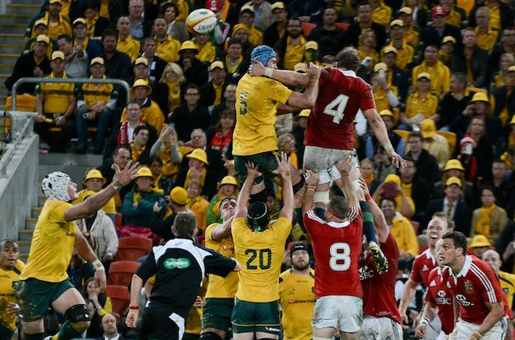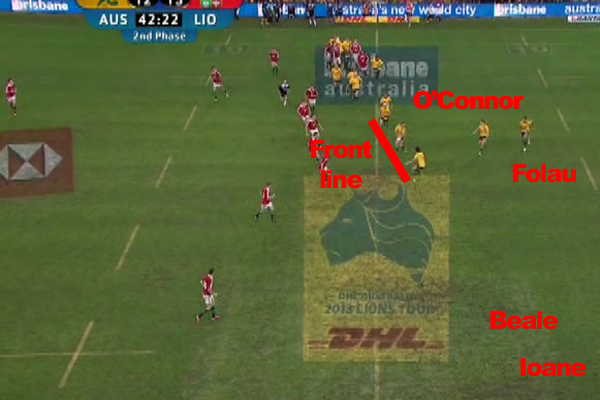Scheduled Website Maintenance
We’re currently in the process of moving to a new and improved server environment. During this transition, the website may experience brief interruptions or temporary outages.
We appreciate your patience while we complete this upgrade. Service will return to normal shortly, with improved performance and reliability.
Thank you for your understanding.
The Wallabies Multi-Phase Play
The lineout to start this play was on the Wallabies right touch line and a wide play was called involving a line of decoy runners in mid-field to attract the interest of the Lions defenders in mid-field with the ball instead being passed behind them to a second line as shown below.
In order to build the front line the Wallabies used a six man lineout with Michael Hooper moving out to the position of #10. Pat McCabe and Adam Ashley-Cooper were outside him. Behind them James O’Connor and Israel Folau started inside Hooper and ran across field with McCabe as the playmaker who received the ball from Genia and passed it out the back to O’Connor who had Folau on his outside hip as another decoy runner. Kurtley Beale and Digby Ioane were wide as the second line of attackers with the ball moving from Genia to McCabe to O’Connor to Beale.
With a wide play called you’d expect that the ball would be thrown towards the back of the lineout with the ball delivered off the top quickly to Genia and that the play would occur on first phase to take advantage of the fact that the Lions defence had to be back 10 metres from the lineout.
The Lions defended at the lineout with only five players in the line and Tom Youngs at receiver which released two forwards into the backline. With an extra man in the backline over the Wallabies the Lions could cover additional width – exactly where the Wallabies wanted to play.
If the Wallabies implemented their play from first phase playing well behind the gain line the Lions would go into an early drift defence, push across field and be waiting out wide to ambush the Wallabies’ wide runners.
Cleverly the Wallabies called a play that involved the forwards throwing the ball towards the back of the lineout but bringing it down as though they were going to drive the ball. That had the immediate effect of dragging all the Lions forwards in the lineout to the maul so they couldn’t leave the lineout early as extra defenders. It would also have had the effect of getting the attention of the two forwards in the Lions backline who would have immediately started thinking about moving back to the forwards to help defend the maul.
Then rather than actually drive the ball too far forward the Wallabies only kept the ball in the maul long enough for the Lions defence to move up. Given that the Lions are using a reasonably narrow defensive structure out wide where they come straight up and then back off if they get outflanked, the move to keep the ball in the maul for a short time dragged the defence up and meant that when the Wallabies moved the ball wide the Lions had to start back peddling as they’d been outflanked, which is a less effective way to make tackles.
The video below shows the play with some further discussion on why it was used.
Unfortunately Beale failed to take advantage of the space the play created and held the ball himself. Because the breakdown was so wide the only forward that was planned to get there was Hooper and with Ioane and Folau joining him they secured the ball.
As the other forwards knew they were not required at the wide breakdown they held in mid-field and were therefore in position to punch the ball up on the third phase.
On the fourth phase Genia shifted the ball back to the left side of the field to Beale – I don’t think that was part of the play and was a decision made on the run based on what the Lions defence had done. Overall it was a well co-ordinated play with the lineout used as more than just a way to restart play.
Lineout Plays Are Pre-Planned
The key behind the play was that it was all pre-planned – the lineout play did not occur in isolation. Once the lineout caller is given the information on what will happen in the overall play they make their call to provide delivery in the right area and in the right way.
When the opposition defends a lineout by leaving space for you to attack, you take that space only if it suits your purpose. You cannot allow the opposition to dictate where you win the ball because as you can see from this example, lineouts are usually part of a much wider plan.
For this reason, I don’t think that the Wallabies tactic of giving the Lions the front of the lineout uncontested in the first test made sense. The Lions pre-planned their plays from each lineout. They called their lineout plays in a huddle before entering the lineout so had already decided where the ball was going even before they found the Wallabies had left the front unmarked. When winning the ball at the front of the lineout didn’t suit their plans they didn’t go there. When winning the ball at the front of the lineout still suited their plans it just made their job too easy.
I hope we see the Wallabies attack the Lions lineout this week to put them under pressure, just like the Brumbies did when they played the Lions.
We are a fan run website, we appreciate your support.
💬 Have you got a news article suggestion? Submit a story and have your say
👀 Follow us on Facebook, Instagram and X.com
🎵 Listen to our Podcasts on Spotify and iTunes
🎥 Watch our Podcasts on YouTube


